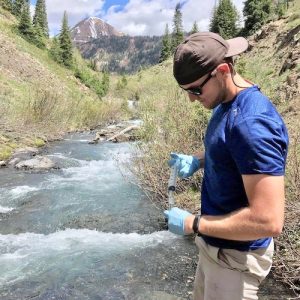Climate Change-Induced Droughts Alter Animal-Driven Nutrient Cycles in Alpine Ponds

FOR IMMEDIATE RELEASE
Jared Balik | jabalik2@ncsu.edu
Michelle Jewell | majewell@ncsu.edu
Animal-driven nutrient flows that are critical to the functioning of pond ecosystems are under increasing threat from climate change.
Nutrients flow through animals on a two-way street. The first way is when animals take nutrients from the environment to thrive and survive. The second is when animals create nutrient sources by making excrement and/or becoming prey. Classic, large-scale, animal-driven nutrient supplies include wildebeest excrement fueling grasslands across African plains and salmon runs that bring nitrogen from the sea to inland streams, lakes, and adjacent forests. This consistent supply of nutrients from animals are essential for supporting the growth of primary producers, such as algae, that support food webs. Another requisite, albeit less consistent, element is water.
The key to life in ponds is water, or–more specifically–the length of time a pond holds water (it’s hydroperiod). Pond hydroperiods naturally vary with differing amounts of precipitation, ground water, and the type of substrate the pond sits on – just to name a few. So, scientists categorize ponds as either permanent, semi-permanent, or temporary, and the animals residing in each of these pond types have hydroperiod-specific life styles.
Including the salamander.
“Animal-driven nutrient supply can provide a large proportion of ecosystem nutrient demand in aquatic ecosystems,” says Jared Balik, Ph.D. alum and current postdoctoral scholar at NC State’s Department of Applied Ecology and co-author of the study. “Our group has previously shown that as subalpine ponds transition from permanent or semi-permanent to temporary, the loss of salamanders prompts shifts in the invertebrate community. Here, we demonstrate that this, in turn, could create nutrient deficits in ponds that formerly had surplus animal-driven nutrient supply.”

While the idea of a pond may conjure Thoreauvian idyll for us, to a salamander, ponds are the ultimate hunting arena. Salamanders are apex predators and therefore have a strong influence on what invertebrate prey species can coexist with them in ponds. But like all pond animals, the life history of salamanders is deeply connected to hydroperiod, and hydroperiods are changing with climate change.
Climate warming is causing pond hydroperiods to become more temporary, which is problematic for salamanders that depend on permanent ponds for their 3-4 year larval development. Some salamanders retain their larval skins and gills into adulthood (these are called “paedomorphs”) and will depend on permanent ponds for the rest of their lives.
When permanent ponds become less permanent, these paedomorph salamanders die out, allowing invertebrates that would normally not survive in a pond with salamanders to outcompete other invertebrates and colonize the pond. Ultimately, this results in less animal biomass and–consequently–less animal excrement, fewer nutrients, and less algal growth. This loss of animal-driven nutrient supply means that ponds are more nutrient limited, leading to even less animal biomass, less excrement, and the downward spiral accelerates…
High elevation areas are experiencing climate change at a faster rate than at sea-level, meaning that they are truly the harbingers of what’s to come (another example is changes to the timing of wildflower blooms). Ponds at sea-level, too, rely on the predictability of hydroperiods over time, and will experience similar ecosystem-wide cascades as climate change descends the mountains.
“Our work shows that climate-driven droughts or shifts in precipitation that alter animal community composition or biomass also likely alter their animal-driven nutrient cycles,” says Balik.
The paper, “Animal-Driven Nutrient Supply Declines Relative to Ecosystem Nutrient Demand Along a Pond Hydroperiod Gradient,” was published in the journal Ecosystems on 17 August, 2021. The paper was co-authored by Emily Jameson from the University of Michigan; the late Scott Wissinger from Allegheny College; Howard Whiteman from Murray State University; and Brad Taylor from NC State University. All authors are also affiliated with the Rocky Mountain Biological Laboratory.
Jared and this work were partially supported by a NSF Graduate Research Fellowship, a Southeast Climate Adaptation Science Center Global Change Fellowship, a Colorado Mountain Club Foundation Al Ossinger Fellowship, RMBL Snyder Endowment Fellowship, and grants from the National Science Foundation.
This post was originally published in Department of Applied Ecology.
- Categories:

